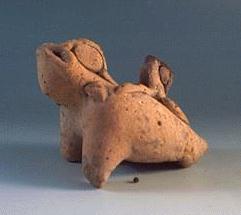
C-405 clay dual whistle
Roberto Velázquez Cabrera
Virtual Research Institute Tlapitzcalzin
Firs version April 8, 2002. Last version January 7, 2003
(Consultation paper)
Versión en Español
Short popular version
A short version of this study was presented in the 1st Special Sessions on Acoustics of Ancient Sounding Instruments included in the 1st International Joint Meeting: 9th Acoustic Mexican Congress (IMA), 144th Meeting of the Acoustic Society of America (ASA) and the 3rd Acoustics Iberoamerican Congress (FIA) in Cancun, Mexico in December 2-6, 2002.
A Lay Language Paper is posted in the ASA World Wide Press Room Yaxchilan's Whistles